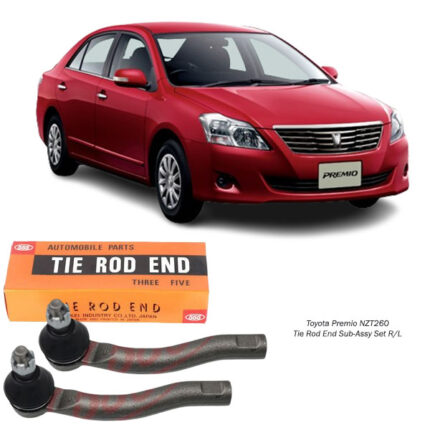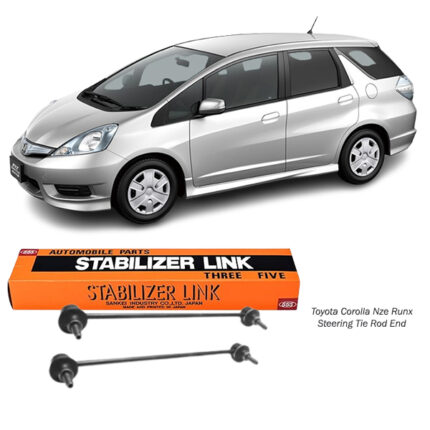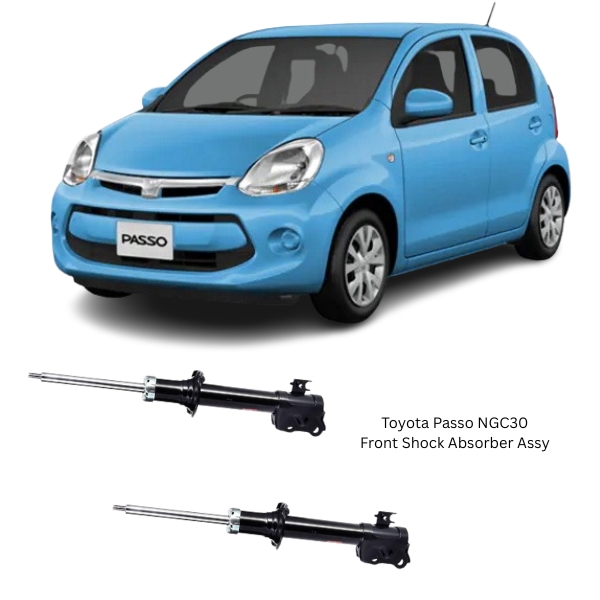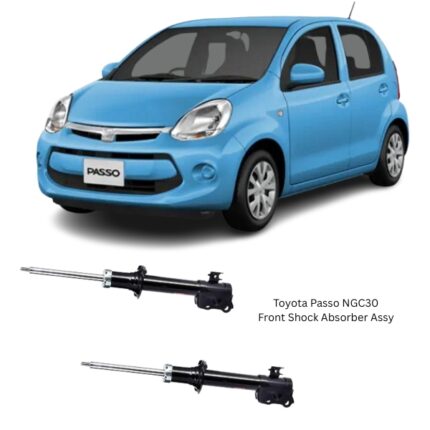Get Toyota Passo NGC30 Front Shock Absorber 332120 in Kenya
The Front Shock Absorber Assembly is a central component of a vehicle’s suspension system, designed to provide damping control and improve both ride comfort and driving safety. Its primary role is to absorb and dissipate kinetic energy from road irregularities, keeping the tires in constant contact with the surface and preventing excessive bouncing. A well-functioning front shock absorber assembly significantly enhances steering response, vehicle stability, and braking performance.
1. Purpose and Function
Shock absorbers, commonly referred to as dampers, are engineered to control the oscillations of the vehicle’s suspension system. When a vehicle travels over bumps, potholes, or uneven roads, the springs compress and expand to absorb the impact. The shock absorber’s job is to regulate this spring motion by dissipating the energy and smoothing out the rebound, thereby preventing the vehicle from bouncing excessively.
In the front suspension, the shock absorber assembly contributes to:
-
Stabilizing the front end of the vehicle
-
Maintaining optimal tire-road contact
-
Enhancing steering control
-
Minimizing nose-diving during braking
-
Reducing body roll when cornering
Without proper damping, a vehicle becomes difficult to control, particularly on rough or winding roads.
2. Components of a Front Shock Absorber Assembly
The front shock absorber assembly is a complex system made up of several key parts that work in unison:
-
Shock Body (Cylinder): The outer tube that holds hydraulic fluid or gas. It houses the internal components that provide damping.
-
Piston and Rod: Attached to the suspension or vehicle frame, the rod moves in and out of the cylinder. The piston at the end of the rod creates resistance as it moves through the hydraulic fluid.
-
Valving System: Consists of small passages and valves that regulate the flow of hydraulic fluid as the piston moves, creating the damping effect. It adjusts automatically depending on road conditions and driving behavior.
-
Mounting Hardware: The shock absorber has upper and lower mounts, often equipped with bushings, to attach it to the vehicle’s frame and suspension arms. These mounts help isolate vibrations and reduce noise.
-
Dust Boot: Protects the piston rod from debris, dirt, and moisture, which can cause corrosion or damage.
-
Bump Stop: Prevents the shock from bottoming out by cushioning the full compression of the suspension.
In some configurations—especially with MacPherson strut systems—the shock absorber is integrated with the coil spring and support bearings, making it an even more critical part of the front suspension.
3. Working Principle
Front shock absorbers work on the principle of hydraulic resistance. As the vehicle moves and the front wheels encounter uneven surfaces, the shocks compress and extend. This movement forces hydraulic oil through the valves inside the shock body. Because the valves restrict the flow of oil, they convert the kinetic energy of motion into heat, which is then dissipated.
There are two main damping stages:
-
Compression Damping: Controls how quickly the shock compresses when the wheel hits a bump.
-
Rebound Damping: Controls how quickly the shock returns to its original position after compression.
By managing both stages, the front shock absorber assembly ensures a balanced, stable ride and prevents continuous bouncing or uncontrolled motion.
4. Types of Front Shock Absorbers
Several variations exist to suit different vehicles and driving conditions:
-
Twin-Tube Shock Absorbers: Feature an inner and outer tube. The inner tube holds the hydraulic fluid, and the outer tube acts as a reservoir. These are common in standard vehicles.
-
Mono-Tube Shock Absorbers: Have a single tube divided into two chambers—one for hydraulic fluid and one for gas. They provide better heat dissipation and performance under stress.
-
Gas-Charged Shock Absorbers: Filled with pressurized nitrogen gas in addition to hydraulic fluid. They reduce foaming, which enhances response time and performance consistency.
-
Strut-Type Shocks (MacPherson Struts): A combination of shock absorber and coil spring in one unit, commonly found in front suspension systems.
-
Adjustable Shock Absorbers: Allow manual or electronic adjustment of damping rates for varying road conditions or driving styles.
5. Benefits of a Properly Functioning Front Shock Absorber
The performance and safety of a vehicle are closely linked to the condition of its shock absorbers. Key benefits include:
-
Enhanced Ride Comfort: Reduces harshness when driving over rough roads.
-
Improved Steering Precision: Offers better control and feedback through the steering wheel.
-
Increased Safety: Maintains tire contact with the road, aiding in effective braking and maneuverability.
-
Reduced Wear on Tires and Suspension: Minimizes excessive movement that can lead to premature wear and tear.
-
Better Load Handling: Helps maintain balance when carrying passengers or cargo, preventing front-end sagging.
6. Signs of Worn Front Shock Absorbers
Over time, shock absorbers wear out due to the high amount of stress they endure. Recognizing early signs of failure can prevent further damage and ensure driving safety:
-
Unusual Noises: Clunking, rattling, or banging sounds from the front suspension
-
Poor Ride Quality: Excessive bouncing, swaying, or rough ride on uneven surfaces
-
Increased Braking Distance: Due to reduced front-end grip and nose-diving
-
Uneven Tire Wear: Caused by inconsistent road contact
-
Fluid Leaks: Visible oil leaking from the shock body
-
Reduced Steering Control: Difficulty maintaining straight-line stability or negotiating turns
If any of these symptoms appear, a professional inspection is recommended.
7. Maintenance and Replacement
Although front shock absorbers are generally maintenance-free, they should be inspected regularly during routine servicing. Factors such as driving conditions, terrain, and vehicle load can affect their lifespan.
When replacing front shock absorbers:
-
Always replace both left and right units together for balanced handling.
-
Ensure all mounting hardware, bushings, and bump stops are in good condition.
-
Follow manufacturer guidelines for torque specs and alignment procedures after installation.
8. Materials and Durability
Front shock absorbers are built from durable, heat-resistant materials to withstand constant movement, hydraulic pressure, and exposure to road debris. The piston rods are often chromed or coated to prevent corrosion. Seals are made from high-grade rubber or polyurethane to maintain oil integrity and prevent contamination.
The fluid used is a specially formulated hydraulic oil that maintains consistent viscosity across temperature ranges. Gas-charged variants include pressurized nitrogen to prevent aeration and improve performance under continuous use.
9. Environmental Considerations
Modern front shock absorbers are designed with sustainability in mind. They are typically recyclable, and many are manufactured using processes that reduce emissions and waste. Environmentally friendly hydraulic fluids and energy-efficient designs are becoming more common in advanced suspension systems.
Follow us on Facebook for more parts.




